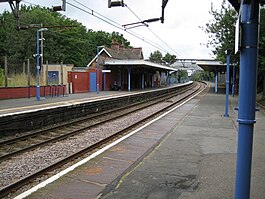Prittlewell railway station
| Prittlewell |
|
|---|---|
 |
|
| Location | |
| Place | Prittlewell |
| Local authority | Southend-on-Sea |
| Grid reference | TQ880870 |
| Operations | |
| Station code | PRL |
| Managed by | Greater Anglia |
| Number of platforms | 2 |
| DfT category | E |
| Live arrivals/departures, station information and onward connections from National Rail Enquiries |
|
| Annual rail passenger usage* | |
| 2011/12 |
|
| 2012/13 |
|
| 2013/14 |
|
| 2014/15 |
|
| 2015/16 |
|
| History | |
| Original company | Great Eastern Railway |
| Pre-grouping | Great Eastern Railway |
| Post-grouping | London and North Eastern Railway |
| 1 October 1889 | Station opened |
| National Rail – UK railway stations | |
| * Annual estimated passenger usage based on sales of tickets in stated financial year(s) which end or originate at Prittlewell from Office of Rail and Road statistics. Methodology may vary year on year. | |
|
|
|
Prittlewell railway station is on the Shenfield to Southend Line in the East of England, serving the residential district of Prittlewell in Southend-on-Sea, Essex. It is 40 miles 67 chains (65.7 km) down-line from London Liverpool Street and is situated between Southend Airport and Southend Victoria. Its three-letter station code is PRL.
Prittlewell itself was the original settlement here, until Southend expanded and engulfed it. The station is close to Prittlewell Priory and to Southend United's home ground, Roots Hall. It is currently managed by Abellio Greater Anglia, which also operates all trains serving it. The typical off-peak service is of three trains per hour to Southend Victoria and three to Liverpool Street (services join the Great Eastern Main Line for London at Shenfield).
Prittlewell is the preceding station to Southend Victoria, the eastern terminus of the line; the typical off-peak service to Southend Victoria is three trains per hour. In the London-bound direction, trains call at all stations along the line to its western terminus of Shenfield, where they join the Great Eastern Main Line to run non-stop to Stratford and Liverpool Street. The typical off-peak service towards London is also three trains per hour (one of which calls additionally at Romford).
...
Wikipedia
